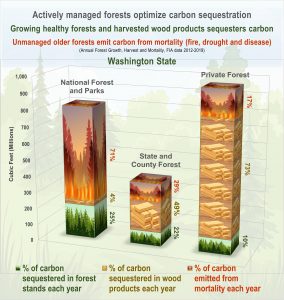WASHINGTON FOREST PROTECTION ASSOCIATION
FOR IMMEDIATE RELEASE – February 14, 2023
Contact: Cindy Mitchell, (360) 791-9372, CMitchell@wfpa.org
Working forests vital to mitigating climate change
Managed forests store more atmospheric carbon than federal lands, UW study finds
Seattle – Working forests are critical to addressing climate change, a University of Washington study finds.
Research examining private, state and federal forests found sustainably managed working forests and the wood products they create play an important role in removing greenhouse gases from our air and keeping that atmospheric carbon sequestered. In fact, applying global warming mitigation metrics, the report found privately owned and managed forests to be the “best-performing forest land and the USFS forest continued to be the worst-performing.”
This study, published in Washington State University’s School of Economic Sciences annual report, uses the 2002 to 2017 Washington state’s forest carbon flux data produced by the U.S. Forest Service (USFS) Forest Inventory Analysis (FIA). The FIA data includes a comprehensive assessment of forest growth, harvest, and natural mortality.
The study shows that managed forests sequester carbon from the atmosphere at a greater rate than unmanaged forests and have significantly lower natural mortality. On average, Washington’s managed forests grow 70% faster per acre (4.92 tons of CO2 per year) than the unmanaged USFS forests (2.88 tons of CO2 per acre per year). While managed forests lose about 14% of their annual growth to natural tree mortality, disease, and fire each year, the unmanaged federal forests lose 71% of their growth due to tree mortality from insects, disease, and fire.
While all forests have been carbon sinks, we have witnessed an unprecedented amount of carbon released in recent decades due to fires. This is especially the situation within the formerly working forests on federal lands, now unmanaged where an accumulation of dead and dying trees have created dangerous fuel loads in densely packed forests.
“Working forests are a critical part of the state’s overall climate change strategy,” said Jason Spadaro, Executive Director for the Washington Forest Protection Association. “In addition to cultivating healthy, resilient forests that clean our air and water, managed forests supply communities with renewable building products that are storing carbon.”
The analysis further concludes increasing use of wood products in building construction from Washington-grown trees provides even greater environmental benefits and is a more “environmentally responsible alternative.” The Pacific Northwest’s robust wood products industry further improves the net global warming mitigation potential of Washington’s forest sector since “fast-growing forests play a vital role in the global carbon cycle as they can sequester and store large amounts of carbon in the forests over relatively short time periods.”
Washington is the second largest softwood lumber producer in the United States, second only to Oregon. Each year, private and public working foresters sustainably harvest 2.8 billion board feet of timber, enough wood to build 350,000 homes.
About the Washington Forest Protection Association
The Washington Forest Protection Association (WFPA) represents private forest landowners growing and harvesting trees on about 4 million acres in Washington State. Members of the 115-year-old association are large and small companies, individuals and families who practice sustainable forestry in Washington’s private forests. For more information, go to www.wfpa.org.
###